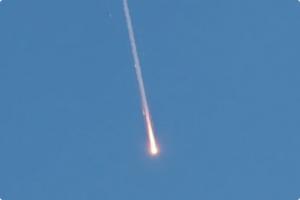The real winners: the strategic fallout of the Israel-Iran war

A missile launched from Iran towards Israel is seen from Tubas in the occupied West Bank, June 2025
Ramzy Baroud writes in The Palestine Chronicle on 24 June 2025:
On June 24, US President Donald Trump announced a truce between Israel and Iran following nearly two weeks of open warfare.
Israel began the war, launching a surprise offensive on June 13, with airstrikes targeting Iranian nuclear facilities, missile installations, and senior military and scientific personnel, in addition to numerous civilian targets.
In response, Iran launched a wave of ballistic missiles and drones deep into Israeli territory, triggering air raid sirens across Tel Aviv, Haifa, and Beersheba and numerous other locations, causing unprecedented destruction in the country.
What began as a bilateral escalation quickly spiraled into something far more consequential: a direct confrontation between the United States and Iran. On June 22, the United States Air Force and Navy carried out a full-scale assault on three Iranian nuclear sites—Fordow, Natanz, and Isfahan—in a coordinated strike dubbed Operation Midnight Hammer. Seven B-2 bombers of the 509th Bomb Wing allegedly flew nonstop from Whiteman Air Force Base in Missouri to deliver the strikes.
The following day, Iran retaliated by bombing the Al-Udeid US military base in Qatar and firing a new wave of missiles at Israeli targets. This marked a turning point. For the first time, Iran and the United States faced each other on the battlefield without intermediaries. And for the first time in recent history, Israel’s long-standing campaign to provoke a US-led war against Iran had succeeded.
Strategic Fallout
Following 12 days of war, Israel achieved two of its goals. First, it pulled Washington directly into its conflict with Tehran, setting a dangerous precedent for future US involvement in Israel’s regional wars. Second, it generated immediate political capital at home and abroad, portraying US military backing as a ‘victory’ for Israel.
